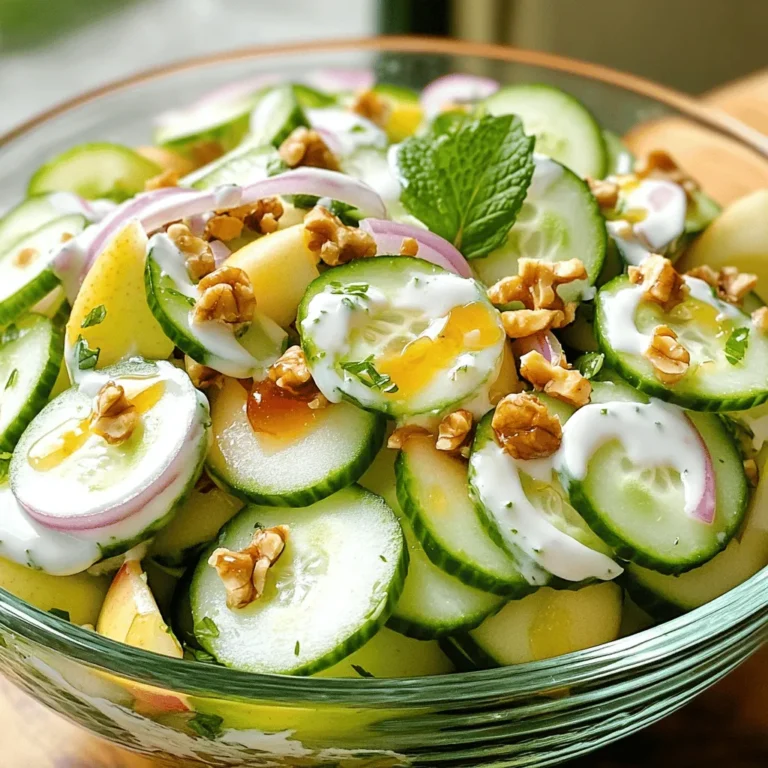Grilled Vegetable Skewers Tasty and Simple Recipe
. Enjoy mixing and matching these ideas! To store leftover grilled vegetable skewers, let them cool first. Place them in an airtight container. You can keep them in the fridge for up to three days. If you want to keep them longer, freezing is a better choice. When you're ready to eat leftovers, you have a few options for reheating. You can use the microwave for quick heat. Place the skewers on a plate and cover them with a damp paper towel. Heat for 30 seconds to 1 minute. You can also reheat them on the grill. This method helps keep the smoky flavor. Just grill them for about 5 minutes over low heat, turning occasionally. If you want to freeze grilled vegetable skewers, first remove the veggies from the skewers. Place the veggies in a single layer on a baking sheet. Freeze them for an hour, then transfer them to a freezer-safe bag. This way, they won't stick together. You can store them in the freezer for up to three months. When you're ready to use them, just thaw them overnight in the fridge. You can then reheat as mentioned above. Enjoy your flavorful grilled veggies anytime! For a full recipe, check out the vibrant grilled vegetable skewers. Yes, you can use frozen vegetables for skewers. However, fresh vegetables are better. Frozen veggies have more water. This can make them mushy when grilled. If you use frozen, thaw them first. Pat them dry to remove excess moisture. This helps keep them firm and tasty. You can tell the vegetables are done by looking at them. They should be tender and have nice grill marks. When a fork goes in easily, they are ready. Each vegetable cooks a bit differently. Zucchini and bell peppers may take less time than mushrooms. Keep an eye on them while grilling. Many dips go well with grilled vegetable skewers. Here are a few great options: - Hummus - Tzatziki - Garlic aioli - Ranch dip - Pesto Each dip adds a new flavor. You can mix and match to find what you love best. Enjoy exploring these tasty options! Grilling vegetable skewers is fun and easy. We covered tasty ingredients, from fresh veggies to zesty marinades. You learned step-by-step methods for marinating and grilling. I shared tips for the best grilling and how to achieve those perfect marks. Explore variations to suit your taste and consider storage tips for leftovers. Remember, this dish is adaptable. You can create a healthy meal that fits your style. Now, it’s your turn to fire up the grill and enjoy delicious skewers!](https://goldendishy.com/wp-content/uploads/2025/06/ba27ef34-bcc3-4460-8414-05014c8a22e5.webp)
Grilled vegetable skewers are a simple and tasty dish perfect for any meal. You can turn fresh veggies into a colorful, flavorful treat. In this recipe, I’ll show you how to make these skewers from scratch, step by step. You’ll learn about the best vegetables to use, how to marinate them, and tips for grilling. Let’s get started on making your new favorite summer dish!
Ingredients
List of Vegetables
– 1 medium zucchini, sliced into thick rounds
– 1 bell pepper (choose your favorite color), cut into 1-inch chunks
– 1 medium red onion, cut into wedges
– 1 cup cherry tomatoes (preferably mixed colors for visual appeal)
– 1 medium yellow squash, sliced into thick rounds
– 8 oz cremini mushrooms, halved
Marinade Ingredients
– 4 tablespoons extra virgin olive oil
– 2 tablespoons balsamic vinegar
– 2 cloves garlic, finely minced
Seasonings and Oils
– 1 teaspoon dried oregano
– 1 teaspoon smoked paprika
– Salt and freshly cracked pepper to taste
– Fresh basil leaves for garnish
When you gather these ingredients, think about how each one adds flavor. The zucchini and squash give a nice crunch. Colorful bell peppers and sweet cherry tomatoes make it bright. The red onion adds a mild sweetness, while the mushrooms bring an earthy taste.
The marinade is key. Olive oil keeps the veggies juicy. Balsamic vinegar adds a tangy sweetness. Garlic gives a punch of flavor. Dried oregano and smoked paprika bring depth. Don’t forget salt and pepper to make everything pop!
Once you have all these ingredients, you are ready to start making your tasty grilled vegetable skewers.
Step-by-Step Instructions
Preparing the Marinade
Start with a big mixing bowl. Add four tablespoons of extra virgin olive oil. Then, pour in two tablespoons of balsamic vinegar. Next, add two cloves of finely minced garlic. Toss in one teaspoon of dried oregano and one teaspoon of smoked paprika. Finish with salt and freshly cracked pepper. Whisk until it smells amazing.
Marinating the Vegetables
Now, it’s time to add the vegetables. Place the zucchini rounds, bell pepper chunks, onion wedges, cherry tomatoes, yellow squash rounds, and halved mushrooms into the bowl. Gently mix everything. Make sure each piece is coated in that tasty marinade. Let the veggies sit for about 10 minutes. This helps the flavors soak in.
Grilling the Skewers
Preheat your grill to medium-high heat. If you use wooden skewers, soak them in water for at least 30 minutes. This stops them from burning. Carefully thread the marinated veggies onto the skewers. Mix up the colors for a fun look. Aim for 4-5 pieces of veggies per skewer.
When the grill is hot, place the skewers on it. Cook for 10-15 minutes. Turn them often to cook evenly. You want them to be tender with nice grill marks. Once done, take them off the grill and let them rest for 2-3 minutes. Sprinkle torn basil leaves on top before serving.Enjoy your grilled vegetable skewers!
Tips & Tricks
Best Grilling Techniques
To grill your skewers well, start with a clean grill. Heat it to medium-high. This helps the veggies cook evenly. Place the skewers at an angle to the grill grates. This method helps cook the vegetables without sticking.
How to Achieve Perfect Grill Marks
To get those pretty grill marks, don’t flip the skewers too soon. Let them sit for about three to four minutes. Check for good sear marks before turning. If you want more marks, rotate them 90 degrees halfway through cooking.
Soaking Wooden Skewers
Soak wooden skewers for at least 30 minutes before using them. This step is key to preventing burning. Use a bowl of water, and add some weight to keep them submerged. You can also add flavor by soaking them in broth or wine. This little trick makes your skewers taste better while grilling.
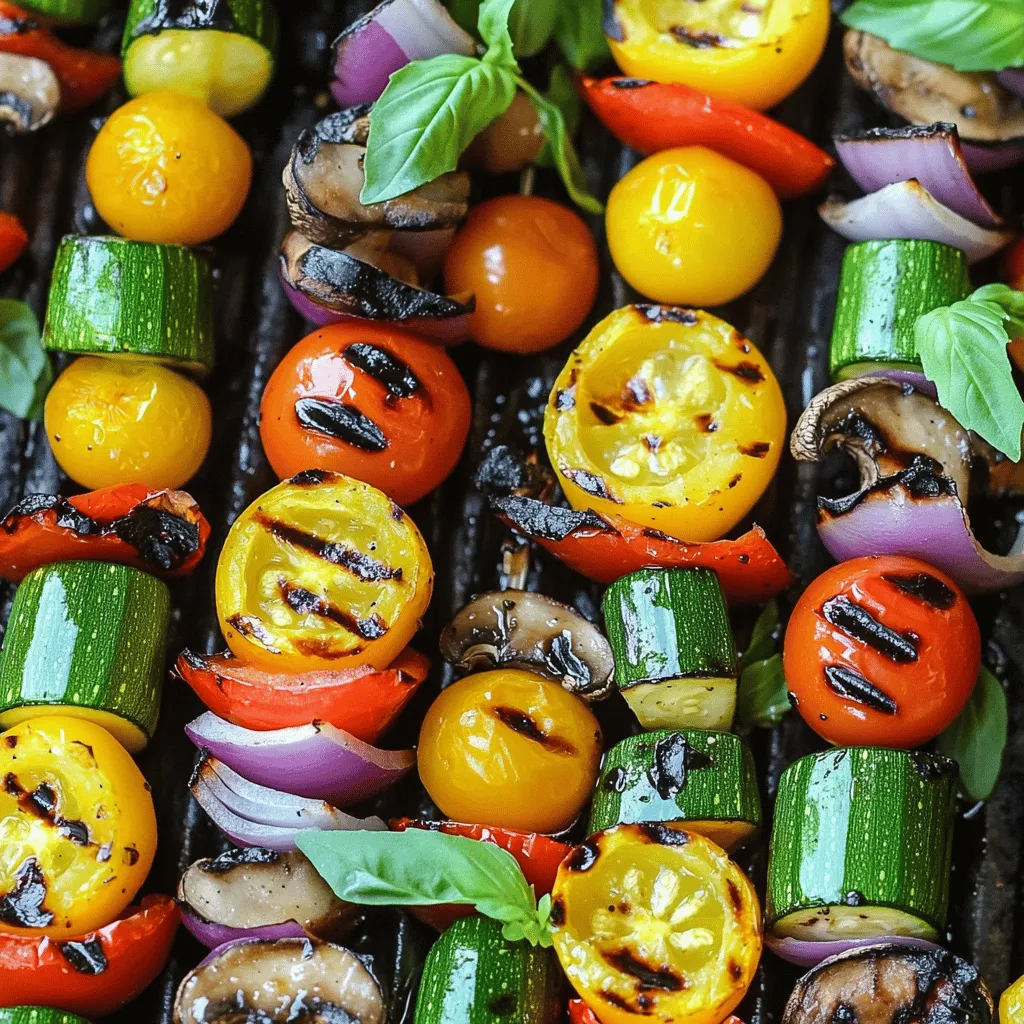
Variations
Different Vegetable Combinations
You can use many kinds of vegetables for your skewers. Try mixing and matching based on what you like. Here are some great ideas:
– Eggplant
– Asparagus
– Cauliflower florets
– Sweet corn
– Pineapple chunks
Each of these adds a unique taste. For example, eggplant gives a rich flavor, while corn adds sweetness. Just cut them into pieces that will fit on your skewers easily.
Suggested Marinades and Sauces
Marinades can change the whole taste of your grilled veggies. Here are some tasty options:
– Lemon juice and thyme
– Soy sauce and ginger
– Yogurt and mint
These marinades not only add flavor but also tenderize the vegetables. Let them soak for about 15 minutes. This will help the veggies absorb the flavors well.
Serving Suggestions: Sides and Dips
You can serve grilled vegetable skewers with many sides and dips. Here are some favorites:
– Hummus
– Tzatziki sauce
– Quinoa salad
These pair well with the skewers. Hummus adds creaminess, while tzatziki gives a refreshing taste. Quinoa salad can be a hearty side.Enjoy mixing and matching these ideas!
Storage Info
How to Store Leftovers
To store leftover grilled vegetable skewers, let them cool first. Place them in an airtight container. You can keep them in the fridge for up to three days. If you want to keep them longer, freezing is a better choice.
Reheating Grilled Vegetable Skewers
When you’re ready to eat leftovers, you have a few options for reheating. You can use the microwave for quick heat. Place the skewers on a plate and cover them with a damp paper towel. Heat for 30 seconds to 1 minute. You can also reheat them on the grill. This method helps keep the smoky flavor. Just grill them for about 5 minutes over low heat, turning occasionally.
Freezing Tips for Grilled Veggies
If you want to freeze grilled vegetable skewers, first remove the veggies from the skewers. Place the veggies in a single layer on a baking sheet. Freeze them for an hour, then transfer them to a freezer-safe bag. This way, they won’t stick together. You can store them in the freezer for up to three months. When you’re ready to use them, just thaw them overnight in the fridge. You can then reheat as mentioned above. Enjoy your flavorful grilled veggies anytime!
FAQs
Can I use frozen vegetables for skewers?
Yes, you can use frozen vegetables for skewers. However, fresh vegetables are better. Frozen veggies have more water. This can make them mushy when grilled. If you use frozen, thaw them first. Pat them dry to remove excess moisture. This helps keep them firm and tasty.
How do I know when the vegetables are done grilling?
You can tell the vegetables are done by looking at them. They should be tender and have nice grill marks. When a fork goes in easily, they are ready. Each vegetable cooks a bit differently. Zucchini and bell peppers may take less time than mushrooms. Keep an eye on them while grilling.
What are some good dips to serve with grilled vegetable skewers?
Many dips go well with grilled vegetable skewers. Here are a few great options:
– Hummus
– Tzatziki
– Garlic aioli
– Ranch dip
– Pesto
Each dip adds a new flavor. You can mix and match to find what you love best. Enjoy exploring these tasty options!
Grilling vegetable skewers is fun and easy. We covered tasty ingredients, from fresh veggies to zesty marinades. You learned step-by-step methods for marinating and grilling. I shared tips for the best grilling and how to achieve those perfect marks. Explore variations to suit your taste and consider storage tips for leftovers. Remember, this dish is adaptable. You can create a healthy meal that fits your style. Now, it’s your turn to fire up the grill and enjoy delicious skewers!
. Enjoy mixing and matching these ideas! To store leftover grilled vegetable skewers, let them cool first. Place them in an airtight container. You can keep them in the fridge for up to three days. If you want to keep them longer, freezing is a better choice. When you're ready to eat leftovers, you have a few options for reheating. You can use the microwave for quick heat. Place the skewers on a plate and cover them with a damp paper towel. Heat for 30 seconds to 1 minute. You can also reheat them on the grill. This method helps keep the smoky flavor. Just grill them for about 5 minutes over low heat, turning occasionally. If you want to freeze grilled vegetable skewers, first remove the veggies from the skewers. Place the veggies in a single layer on a baking sheet. Freeze them for an hour, then transfer them to a freezer-safe bag. This way, they won't stick together. You can store them in the freezer for up to three months. When you're ready to use them, just thaw them overnight in the fridge. You can then reheat as mentioned above. Enjoy your flavorful grilled veggies anytime! For a full recipe, check out the vibrant grilled vegetable skewers. Yes, you can use frozen vegetables for skewers. However, fresh vegetables are better. Frozen veggies have more water. This can make them mushy when grilled. If you use frozen, thaw them first. Pat them dry to remove excess moisture. This helps keep them firm and tasty. You can tell the vegetables are done by looking at them. They should be tender and have nice grill marks. When a fork goes in easily, they are ready. Each vegetable cooks a bit differently. Zucchini and bell peppers may take less time than mushrooms. Keep an eye on them while grilling. Many dips go well with grilled vegetable skewers. Here are a few great options: - Hummus - Tzatziki - Garlic aioli - Ranch dip - Pesto Each dip adds a new flavor. You can mix and match to find what you love best. Enjoy exploring these tasty options! Grilling vegetable skewers is fun and easy. We covered tasty ingredients, from fresh veggies to zesty marinades. You learned step-by-step methods for marinating and grilling. I shared tips for the best grilling and how to achieve those perfect marks. Explore variations to suit your taste and consider storage tips for leftovers. Remember, this dish is adaptable. You can create a healthy meal that fits your style. Now, it’s your turn to fire up the grill and enjoy delicious skewers!](https://goldendishy.com/wp-content/uploads/2025/06/ba27ef34-bcc3-4460-8414-05014c8a22e5-300x300.webp)

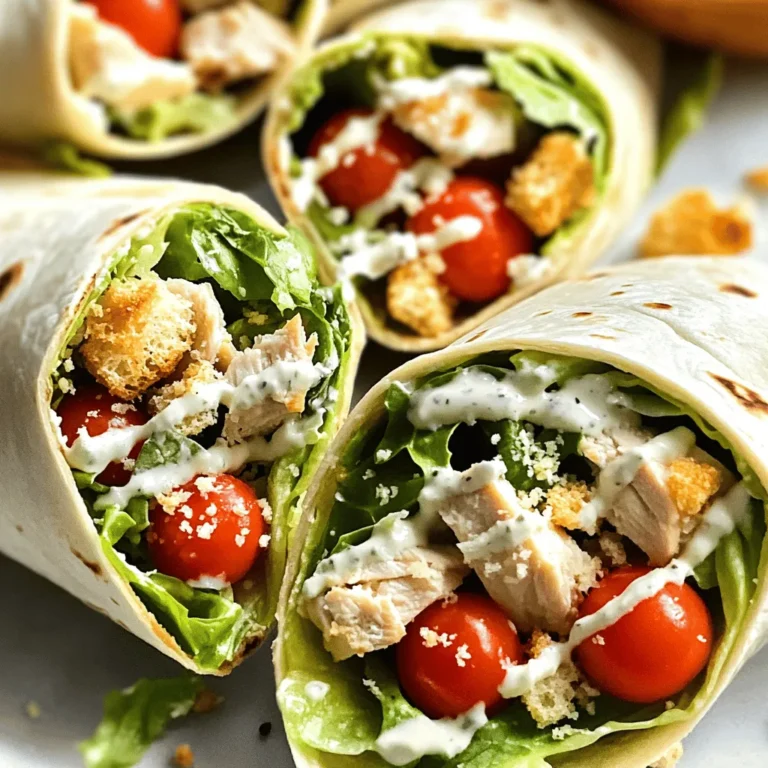
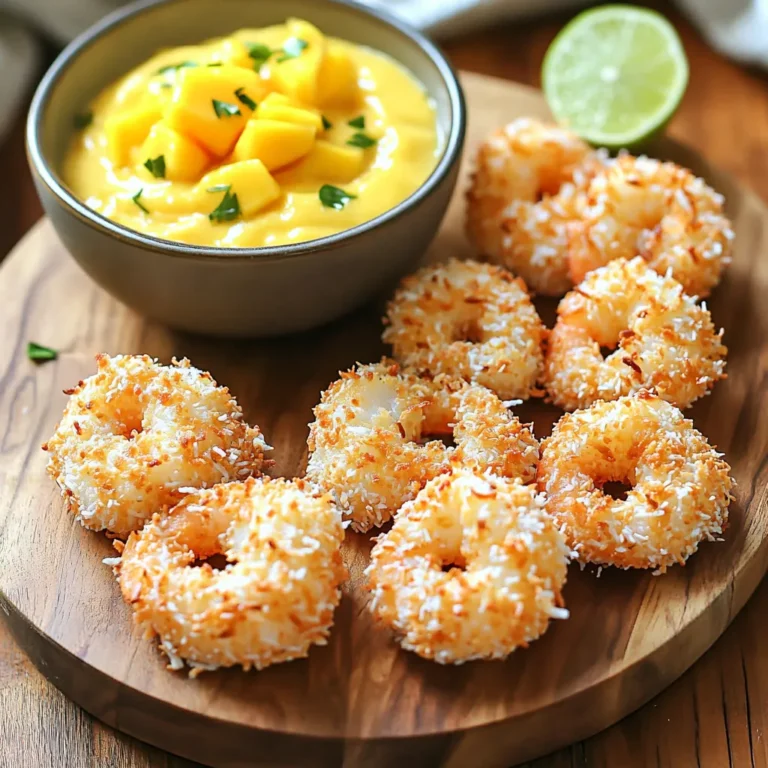
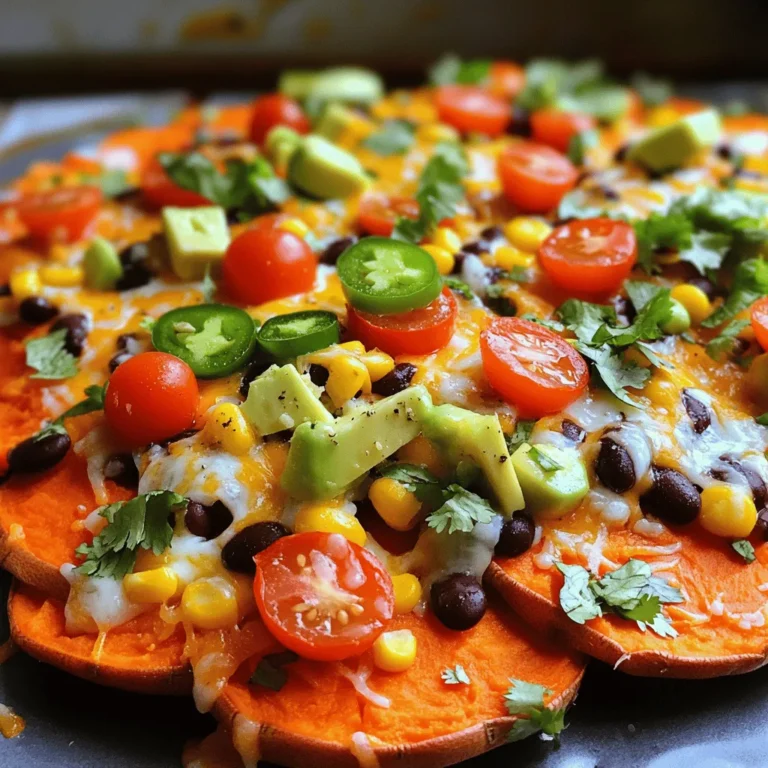
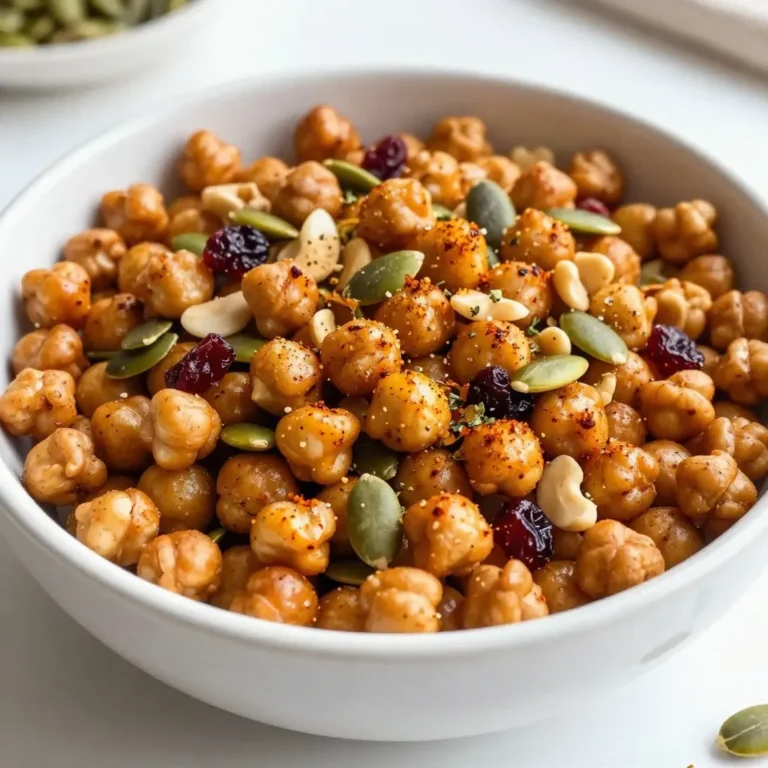
![- 8 oz (about 225g) rotini or penne pasta - 1 cup cherry tomatoes, halved - 1 cucumber, finely diced - 1/2 red onion, finely chopped - 1 bell pepper (any color), diced into small pieces - 1 cup Kalamata olives, pitted and sliced in half - 1 cup feta cheese, crumbled into bite-sized pieces - 1/4 cup fresh parsley, roughly chopped - 1/4 cup high-quality olive oil - 2 tablespoons red wine vinegar (optional for flavor) - 1 tablespoon freshly squeezed lemon juice - 1 teaspoon dried oregano - Sea salt and freshly cracked black pepper to taste You can make this salad your own. Try adding: - Grilled chicken or shrimp for protein - Artichoke hearts for extra flavor - Sun-dried tomatoes for a sweeter touch - Avocado for creaminess - Different herbs like mint or dill for freshness Fresh ingredients shine in this salad. Here’s how to pick the best: - Choose firm, bright cherry tomatoes. They should smell sweet. - Look for a cucumber with smooth skin. It should feel heavy for its size. - Pick bell peppers that are shiny and firm. Avoid any with soft spots. - For olives, select Kalamata that are dark and plump. - Get feta cheese that is crumbly and moist, not dry. Using fresh ingredients elevates the flavor and makes your Easy Greek Pasta Salad a true delight. For the full recipe, check out the Mediterranean Delight Pasta Salad 🥗! Start by boiling a large pot of salted water. This step is key to flavor. Add 8 oz of rotini or penne pasta. Cook it according to the package directions until it is al dente. This should take about 8-10 minutes. Once the pasta is cooked, drain it well. Rinse the pasta under cold water to stop the cooking and cool it down. This keeps the texture just right. In a large mixing bowl, add the cooled pasta. Next, toss in 1 cup of halved cherry tomatoes, 1 diced cucumber, and 1/2 finely chopped red onion. Don’t forget 1 diced bell pepper, which adds color and crunch. Add 1 cup of Kalamata olives that you’ve pitted and sliced. Finally, sprinkle in 1/4 cup of roughly chopped fresh parsley. Mix everything well to combine the flavors. In a small bowl, whisk together the dressing. Use 1/4 cup of high-quality olive oil. Add 2 tablespoons of red wine vinegar or fresh lemon juice if you prefer a brighter taste. Squeeze in 1 tablespoon of lemon juice for extra zest. Mix in 1 teaspoon of dried oregano. Season with sea salt and freshly cracked black pepper to taste. Whisk until the ingredients blend into a smooth dressing. Drizzle the dressing over the pasta and vegetable mix. Toss gently to coat all the ingredients well with the dressing. This step is crucial for flavor. Now, softly fold in the crumbled feta cheese. Be careful not to break the cheese too much; you want those nice chunks. For the best flavor, cover the salad with plastic wrap. Place it in the refrigerator for at least 20 minutes. This waiting period allows the flavors to blend beautifully. After chilling, taste the salad. Adjust the seasoning with more salt, pepper, or lemon juice if needed. Enjoy making this Easy Greek Pasta Salad! For the Full Recipe, check the link. To make the best Greek pasta salad, start with the right pasta. Use rotini or penne, as they hold the dressing well. Cook the pasta just right. It should be al dente, so it stays firm. Rinse it under cold water after cooking. This step cools the pasta and stops it from cooking more. Next, chop your veggies evenly. This way, each bite has a bit of everything. Fresh ingredients bring the best flavor. Use ripe cherry tomatoes and a crisp cucumber. Kalamata olives add a nice briny touch. Don’t forget the feta cheese! It should be crumbly but not too small. Many people overcook the pasta. This makes it mushy and not enjoyable. Also, don’t skip the rinsing step. It keeps the pasta from sticking together. Another mistake is not seasoning enough. Taste your salad after mixing. You might need more salt, pepper, or lemon juice. Always adjust to make it perfect for your palate. Lastly, let your salad chill before serving. This step allows the flavors to blend and deepen. A quick chill of at least 20 minutes works wonders. For more flavor, try adding fresh herbs. Basil or dill can brighten the dish. If you like heat, add a pinch of red pepper flakes. This gives your salad a nice kick. Experiment with your dressing too! Swap red wine vinegar for lemon juice for a brighter taste. A splash of balsamic vinegar can also add depth. Lastly, if you want a creamier salad, mix in some Greek yogurt. It adds richness without overpowering other flavors. For the full recipe, check out the Mediterranean Delight Pasta Salad. Enjoy making this simple and colorful dish! {{image_4}} You can easily add proteins to your Easy Greek Pasta Salad. Grilled chicken or canned tuna are great choices. They boost the dish's nutrition and make it more filling. For chicken, use cooked, diced pieces. For tuna, just drain and flake it. Mix your chosen protein right into the salad for a complete meal. Feel free to switch up the veggies in your pasta salad. Different colors and flavors keep it exciting. Try adding artichoke hearts, sun-dried tomatoes, or roasted red peppers. You can also use zucchini or spinach for a fresh twist. Just chop them into small pieces and mix them in. If you want a vegan version, swap feta cheese for a plant-based alternative. Nutritional yeast can also add a cheesy flavor without dairy. For gluten-free options, use gluten-free pasta. There are many types available now. This way, you can enjoy the salad without worry. Check labels to ensure all ingredients meet your dietary needs. Find the full recipe at [Full Recipe]. To keep your Easy Greek Pasta Salad fresh, store it in an airtight container. This helps prevent air and moisture from spoiling your salad. If you have leftovers, make sure to cool the salad before sealing it. This keeps the flavors intact and avoids sogginess. You can also separate the dressing if you want to keep the salad crisp for longer. This salad tastes best cold, so there’s no need to reheat it. If you find the pasta has absorbed the dressing, add a splash of olive oil or lemon juice. Toss it gently to revive the flavors. If you stored the salad in the fridge, let it sit at room temperature for about 10 minutes before serving. This will enhance the taste and texture. Your Easy Greek Pasta Salad can last about 3 to 5 days in the fridge. Always check for any signs of spoilage. Look for changes in color or texture. If you notice any off smells, discard it. Trust your senses; if something seems off, it’s better to be safe. Enjoy your salad while it's fresh for the best taste! You can store Easy Greek Pasta Salad in the fridge for about 3 to 5 days. Keep it in a sealed container to keep it fresh. If you see any signs of spoilage, like an off smell or discoloration, it's best to toss it out. Yes, you can make this salad ahead of time! In fact, it tastes better after sitting for a while. The flavors meld together nicely. I recommend making it a few hours in advance or even the night before. Just remember to add the feta cheese right before serving to keep it fresh. Greek Pasta Salad pairs well with various dishes. You can serve it alongside grilled chicken, lamb, or fish. It also works great as a side for burgers or sandwiches. If you're having a picnic, it's perfect with some crusty bread and hummus. Yes, you can substitute feta cheese if you prefer. Try using goat cheese or ricotta for a different flavor. For a dairy-free option, you can use a plant-based cheese. Just keep in mind that the taste will change slightly, but the salad will still be delicious! This blog post covers how to make Easy Greek Pasta Salad. We discussed essential ingredients and tips for freshness. You learned steps to prepare the salad, mix the ingredients, and make the dressing. We highlighted ways to enhance flavors and avoid common mistakes. Plus, you can try various protein and veggie options. Finally, you got storage tips to keep the salad fresh. Enjoy making this salad for your next meal or gathering! It’s simple, tasty, and fun to customize.](https://goldendishy.com/wp-content/uploads/2025/06/0fc22d26-3c6f-4a8e-aae2-92058968a948-768x768.webp)
